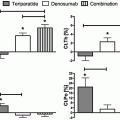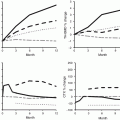All fractures are located along the femur from distal to lesser trochanter to proximal to supracondylar flare
PLUS
Major features: (four of five are required)
– No trauma or minimal trauma
– Fracture originates in lateral cortex and is substantially transverse but may become oblique as progresses medially
– Fracture is noncomminuted or minimally comminuted
– Complete fractures extend through both cortices and may be associated with medial spike; incomplete fractures involve only lateral cortex
– Localized periosteal or endosteal thickening of lateral cortex is present at fracture site (beaking or flaring)
Minor features: (none are required)
– Generalized increase in cortical thickness of femoral diaphysis
– Unilateral or bilateral prodromal symptoms
– Bilateral incomplete or complete femoral diaphysis fractures
– Delayed fracture healing
Patient Characteristics
The vast majority of subtrochanteric and diaphyseal femur fractures are caused by major trauma such as motor vehicle accidents, particularly in men. However, with increased age, the incidence of lower-energy trauma as a cause of these fractures rises until the incidence in women overtakes that of men [2]. This parallels the rise in hip fractures in elderly women [3]. AFFs , like hip and other fragility fractures, also predominantly affect the older female patient population.
There is some evidence that patients affected by AFFs differ from “typical” hip fracture patients with regard to level of functioning, particularly after surgery. A study of 191 operatively treated AFF patients recently presented at the Orthopaedic Trauma Association meeting [4] noted that 93 % were living in their homes at the time of final follow-up, with a mortality rate of 2 %. In contrast, a study of 87 subtrochanteric fracture patients showed a mortality rate of 25 % at 1 year, and 71 % of patients were unable to return to their previous living arrangement [5]. This suggests that there may be a difference in the two populations at baseline, as well as in their response to the same operative treatment (cephalomedullary nailing).
Task Force Document: Major Features
The ASBMR task force definition lists “minimal to no trauma” as a major feature of AFFs that must be present in order for a fracture to be classified as such. While low-energy trauma that causes hip (femoral neck and intertrochanteric) fractures is common among the elderly, the vast majority of subtrochanteric and femoral shaft fractures in the general population are caused by major trauma such as motor vehicle accidents. Even in cases where low-energy trauma results in femoral shaft fractures in older patients, however, the fracture configurations are different than those seen in AFFs [6].
The most common mechanism of injury for AFFs appears to be either a ground-level fall or nontraumatic activities such as walking or stepping off a curb. In an early study [7], five of nine patients with AFFs had femoral shaft fractures, and all occurred during walking or turning. Another study of 25 patients [8] with AFFs who were matched with a cohort of similar age showed a ground-level fall to be the cause of 96 % of the AFFs.
Task Force Document: Minor Features
The presence of prodromal symptoms in the affected extremity is very common in AFFs , occurring at a rate of approximately 70 % [1]. This figure is based on data accumulated from case series reviewed by the ASBMR task force, but the number in individual studies varies, and a recent large series noted a 32 % rate of prodromal symptoms [4]. Smaller series vary, with 41 % [9], 63 % [10], 67 % [11], and 76 % [12] rates of prodromal pain, although those series involved low patient numbers (maximum n = 22).
Prodromal pain first occurs any time from 2 weeks to several years prior to the fracture [9, 12]. It commonly presents as pain in the anterior or lateral thigh and often in the groin as well [12]. The presence of prodromal pain may be the first sign necessitating a radiograph in these patients, which may then show a stress lesion in the cortex (discussed elsewhere in this book). Both stress lesions and the presence of prodromal pain have been shown to increase the risk of subsequent fracture [13]. The presence of prodromal pain , particularly in a patient on bisphosphonates, should be a concerning signal that warrants clinical and radiologic investigation.
Another major clinical characteristic of AFFs is the presence of contralateral symptoms and/or fractures . These fractures can occur both sequentially and simultaneously and are often associated with prodromal pain. Initial small studies [12, 14] showed an approximately 20 % rate of contralateral fractures, and in one study, two out of the three patients with bilateral fractures had sustained them simultaneously [14]. Another study of seven patients with AFFs identified four with a stress reaction on the contralateral side, with all four patients presenting with prodromal pain [15]. One of the four eventually fractured through the site of stress reaction after a fall, while the other three patients received a prophylactic cephalomedullary nail.
One recent series of 191 operatively treated AFFs confirmed the contralateral fracture rate reported in a smaller series [12], noting a 19 % rate of contralateral fractures, 20 months on average after their index procedure [4]. Notably, 50 % of those patients had discontinued bisphosphonate treatment at the time of their first procedure. Also in that study, 32 % of the patients with contralateral fractures who had information available had prodromal pain, and 59 % (10/17 with available data) had a stress reaction on X-ray prior to their contralateral fracture [4]. These data underscore the need to carefully evaluate the contralateral femur in AFF patients, even if prodromal symptoms are not present.
Another clinical feature of AFFs that may be found in the patient history is an association with several comorbid conditions. One is hypophosphatasia , an error of metabolism in which a loss-of-function mutation occurs in the gene encoding alkaline phosphatase. This results in pyrophosphate accumulation and causes osteomalacia due to impaired mineralization. This, in turn, can result in femoral pseudofractures that are often bilateral and occur in the subtrochanteric region [16]. This further supports the hypothesis that bisphosphonate treatment is related to AFFs , because bisphosphonates are analogs of inorganic pyrophosphate. Other conditions that may be found on presentation of AFFs are rheumatoid arthritis and breast cancer. An analysis of the FDA Adverse Effect Reporting System (FAERS ) showed a 7 % rate of rheumatoid arthritis and a 2 % rate of breast cancer in suspected AFF patients. In the case of breast cancer, it is unclear whether concomitant administration of bisphosphonates is the cause of the association between this malignancy and AFFs, and several studies [17, 18] have examined this question.
The last aspect of AFF presentation mentioned in the task force document is the association with medication use in the patient’s history. In a 2011 study, Park et al. [19] showed that although the absolute risk of AFFs was very low, the odds ratio was 2.74 in the case of older women taking bisphosphonates for greater than 5 years. Another cohort analysis of 12,777 women greater than age 55 isolated 59 patients with AFFs, with an adjusted odds ratio of 33.3 for bisphosphonate use (i.e., 78 % of the AFFs vs. 10 % who did not have AFFs used bisphosphonates) [20]. The popularity of bisphosphonates has come hand in hand with a rise in subtrochanteric fractures and a decline of “typical” hip fractures, particularly in females [21]. Glucocorticoids are also implicated in AFFs [22, 23], as well as in general osteoporotic fractures [24]; one study of 20 AFF patients gave a 5.2 odds ratio for developing an AFF if a patient used glucocorticoids for more than 6 months [23]. Lastly, proton pump inhibitors such as omeprazole have been found in the medication history of approximately 34–39 % of AFF patients [1]. Like glucocorticoids, proton pump inhibitors are also noted to be associated with osteoporotic hip and wrist fractures if they are used long-term [25].
Stay updated, free articles. Join our Telegram channel

Full access? Get Clinical Tree







